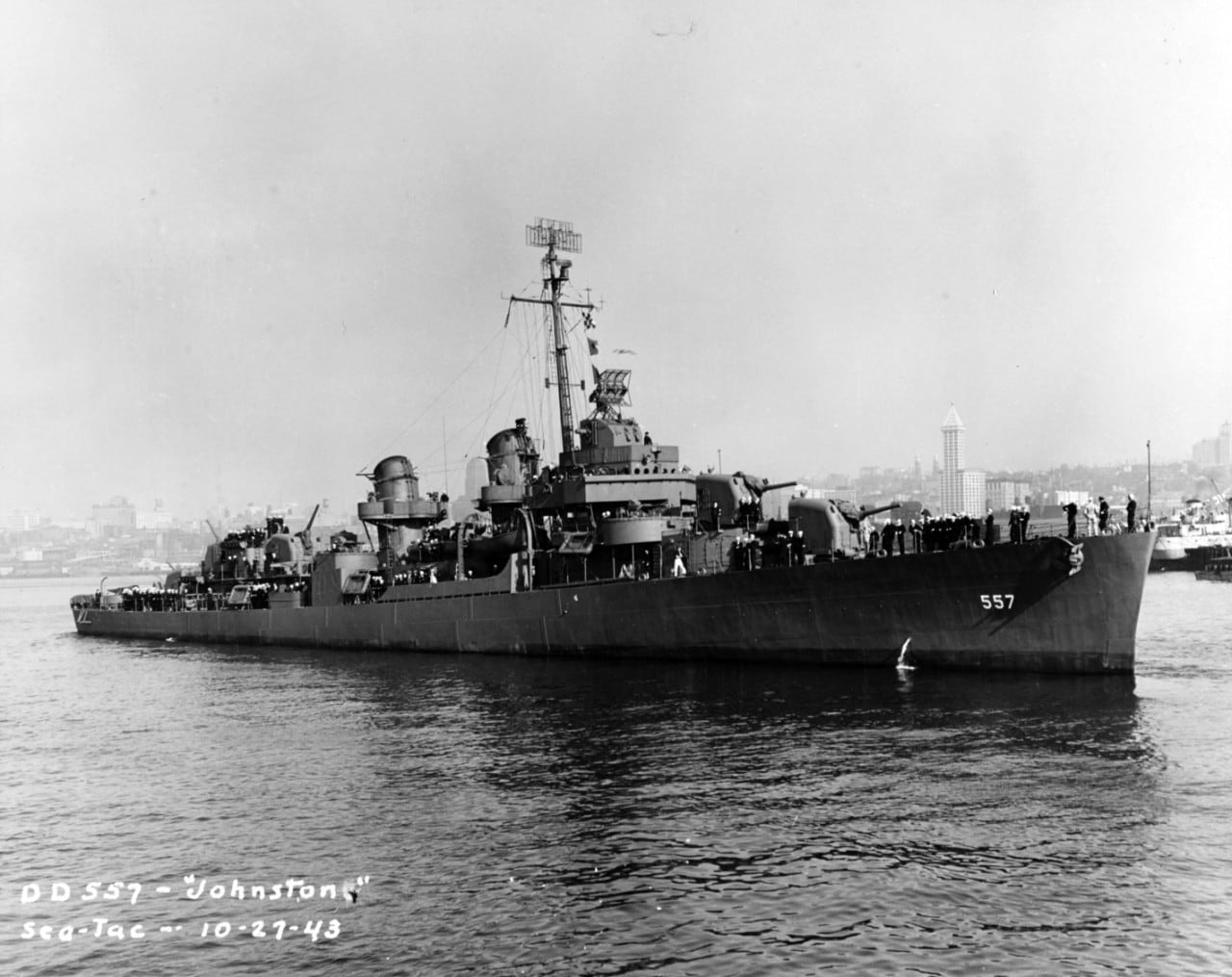After nearly 77 years undisturbed on the floor of the Pacific, the USS Johnston — sunk during the Battle of Leyte Gulf — has been confirmed found. Resting more than 20,000 feet below surface, the shipwreck is the deepest ever discovered, the Naval History and Heritage Command first reported.
In October 2019 the wreck of a Fletcher-class destroyer was located on the edge of an undersea cliff by the Vulcan Inc. research vessel Petrel, but the identity of the ship remained unconfirmed until recently. Now, imagery from the undersea technology company Caladan Oceanic, led by retired naval officer Victor Vescovo, has identified the ship by its hull number, 557.
The warship was lost during the Battle off Samar, part of the larger, sprawling Battle of Leyte Gulf on October 25, 1944.
With the outcome of the war already decided, the Japanese were seeking little more than a “fitting place to die,” according to their planning documents.
Despite technological superiority, American hubris, largely that of Admiral Bill Halsey, led unsuspecting U.S. sailors into the hands of a much larger Japanese force comprised of four battleships — including super-battleship Yamato — six heavy cruisers, two light cruisers, and 11 destroyers.
Commander of the Pacific Fleet Adm. Chester Nimitz, attempting to make sense of the confused situation from Hawaii, dispatched a rare, sarcastic rebuke to Halsey that would become one of the most famous messages in naval history:
“Where repeat where is Task Force 34? The world wonders.”

The crew of the USS Johnston had no time to wonder, however.
Led by Commander Ernest Evans, the heavily outmatched destroyer “charged into a massive line of Japanese warships in order to protect the American landing force attempting to liberate the Philippine Islands,” the NHHC wrote.
The move reflected Evans’ assertion on the day of the Johnston’s commissioning, when he declared, “This is going to be a fighting ship. I intend to go in harm’s way, and anyone who doesn’t want to go along had better get off right now.”
Enemy shells assailed the onrushing Johnston, striking the destroyer and inflicting widespread damage and casualties. Despite being seriously wounded in the attack, Evans ordered a second assault.
With no remaining torpedoes and limited firepower left, Johnston’s brave but doomed attack continued unabated, firing 30 more rounds into a 30,000-ton Japanese battleship.
As enemy ships began strafing the escort carrier Gambier Bay, Evans gave the order to “commence firing on that cruiser, draw her fire on us and away from Gambier Bay.” The Japanese responded in turn.
“After two-and-a-half hours, Johnston — dead in the water — was surrounded by enemy ships,” the Naval History Center release said. “At 9:45 a.m., Evans gave the order to abandon ship. Twenty-five minutes later, the destroyer rolled over and began to sink.”
Of the 327-man crew, only 141 survived. Evans was not among them. The commander was later awarded the Medal of Honor, becoming the first Native American in the U.S. Navy and one of two destroyer captains in WWII to receive the honor.
“In no engagement in its entire history has the United States Navy shown more gallantry, guts and gumption than in the two morning hours between 0730 and 0930 off Samar,” Rear Adm. Samuel Eliot Morison wrote.
Because of Evans’ bravery and Johnston’s sacrifice in diverting Japanese attention, General Douglas MacArthur was able to retake the Philippines.
However, due to Halsey’s miscalculations, “the Battle off Samar was for a time the victory whose name the navy dared not speak,” historian Jim Hornfischer noted.
Now, the final resting place of the Johnston and the gravesite of its sailors can be properly honored.
The Caladan Oceanic team, at the conclusion of its expedition, somberly laid a wreath in the vicinity of the battle site to salute the 186 lives lost that day.
Claire Barrett is the Strategic Operations Editor for Sightline Media and a World War II researcher with an unparalleled affinity for Sir Winston Churchill and Michigan football.





